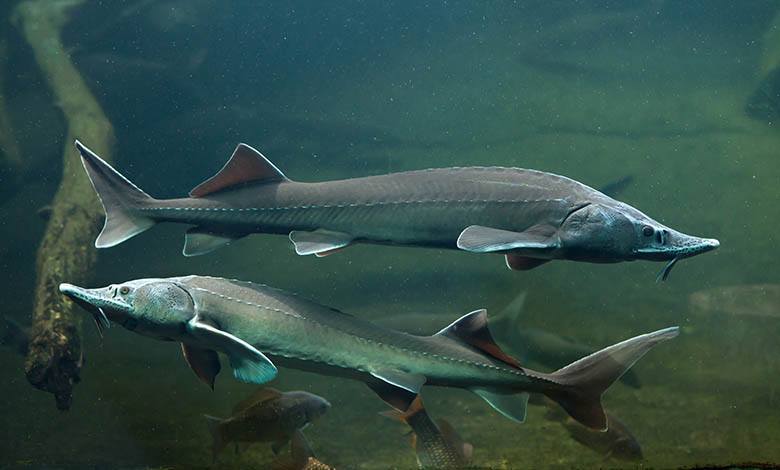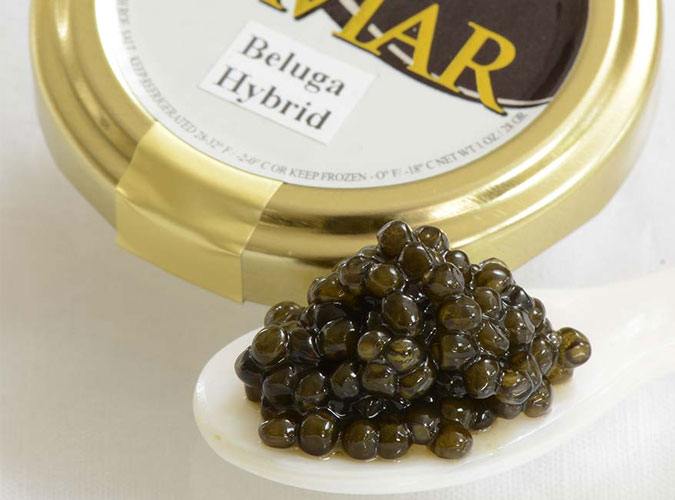About Beluga Caviar
Beluga caviar is by far the most highly prized and expensive of all the caviar varieties. Originating in the Caspian Sea, the beluga (Huso Huso) lays the largest and softest roe of any sturgeon. Beluga sturgeon caviar fish eggs range in color from light gray to black, and are considered a luxury commodity, with a price often somewhere between $5000 and $10,000 per kilogram. Caviar connoisseurs consider eating beluga caviar one of life’s greatest pleasures, raving about its impossibly smooth texture and life-enriching taste.
Okay, so it’s delicious. But lots of things are delicious. So why has this specifically become such a prized and expensive food? The answer lies in the fish itself. The beluga sturgeon is huge, in rare cases even weighing more than 2000 lbs and growing over 20 feet in length. It can also live for over 100 years. Consequently, the female sturgeon has a very long maturation cycle, taking around 25 years before she’s ready to lay eggs. This means that a caviar farmer must invest huge amounts of time, money and resources feeding and raising a sturgeon before recouping their investment. This, combined with the fish’s bountiful size and unbeatable flavor, makes it the food to end all foods.
History of beluga caviar
The precise moment when humans began to eat caviar is not well-documented, but it was probably a natural segway from eating sturgeon meat to inevitably encountering the fish’s roe and experimenting with eating it.
The Persians are often credited with being among the first to appreciate caviar. Later, the practice spread to Russia, where it gained immense popularity among the nobility. By the 12th century, Russian czars were regularly and thoroughly indulging, and thus it became a symbol of luxury and wealth. It was also the Russian Orthodox Church who played a role in popularizing caviar as it deemed it an acceptable food to eat during fasting periods.
Caviar's journey to Western Europe is intertwined with trade and cultural exchanges between the East and West. By the 16th century, European aristocrats were acquiring a taste for caviar, often through interactions with Russian nobility. As trade routes expanded and preservation techniques improved, caviar became more accessible to the elite across Europe.
Harvesting Beluga Caviar
The most predominant harvesting method for caviar results in the death of the female sturgeon – meaning that once harvested, the fish dies. Unfortunately, there are no other effective methods available right now that keep the fish alive, and it’s what has caused this species, the Huso huso, to come perilously close to extinction. Not only that, but rampant overfishing and contamination of the natural waterway didn’t allow the populations to recover, ultimately leading to an international ban on this delicacy.

The Ban on Beluga Caviar
Wild beluga caviar availability has always depended on several factors, ranging from political regulation to climate change to habitat loss, but in recent years its status has become especially delicate. In 2004, the US Fish and Wildlife Service announced the species as threatened. Even after this, wild beluga populations continued to decline dramatically, and in 2005, the United States banned the sale and import of this highly prized fish and its eggs, rendering its purchase illegal.
Farmed in the United States
For foodies with a penchant for authentic Beluga caviar, there exists only a solitary, legally sanctioned source located in Bascom, Florida: one of the world's most extensive farms. The farm is under the stewardship of Mark Zaslavsky, a Russian immigrant who was once involved in the importation of this species into the United States prior to the 2005 ban. Presently, he stands as the exclusive proprietor of the lone legally recognized Beluga farm in the country.
However, the question arises: How does this operation adhere to regulations?
According to Zaslavsky, his farm harvests sturgeon eggs from the same group that was originally imported in 2003 and 2004, known as the "brood stock." Naturally, Zaslavsky is deeply committed to not only sustaining his own population but also contributing to the broader revival of the species. His company made a significant donation of over 160,000 fertilized eggs to organizations dedicated to repopulation.
Of course, there are plenty of alternatives to beluga caviar, many available right here at Gourmet Food Store.
What are the Best Substitutes for Beluga?

No two caviar are precisely alike, but we can often find close approximations when our favorite caviar isn’t available. When it comes to substitutes for beluga, we have several types available in our family of brands:
- Beluga Hybrid Caviar – Malossol Farm Raised: yielded from a unique crossbreed of Beluga (Huso huso) and Siberian sturgeon (Acipenser baerii).
- Kaluga Fusion Sturgeon Caviar – Malossol Farm Raised: The Kaluga sturgeon is among the largest freshwater fish in the world. Found primarily in the Amur River of the Russian Far East, its eggs are close in mouth-wateringly smooth texture and mild, buttery taste to beluga, making this an excellent (and comparatively very affordable) substitute.
- Special Reserve Russian Osetra Caviar – Malossol Farm Raised: Osetra Caviar is almost as highly prized as beluga, which makes this special reserve Osetra among the best caviar you can find online. Farmed under immaculate and sustainable conditions in top-of-the-line aquafarms in Israel, this authentic osetra produces large, golden, gem-like eggs that are bursting with superb, buttery flavor. As exquisite as they come!